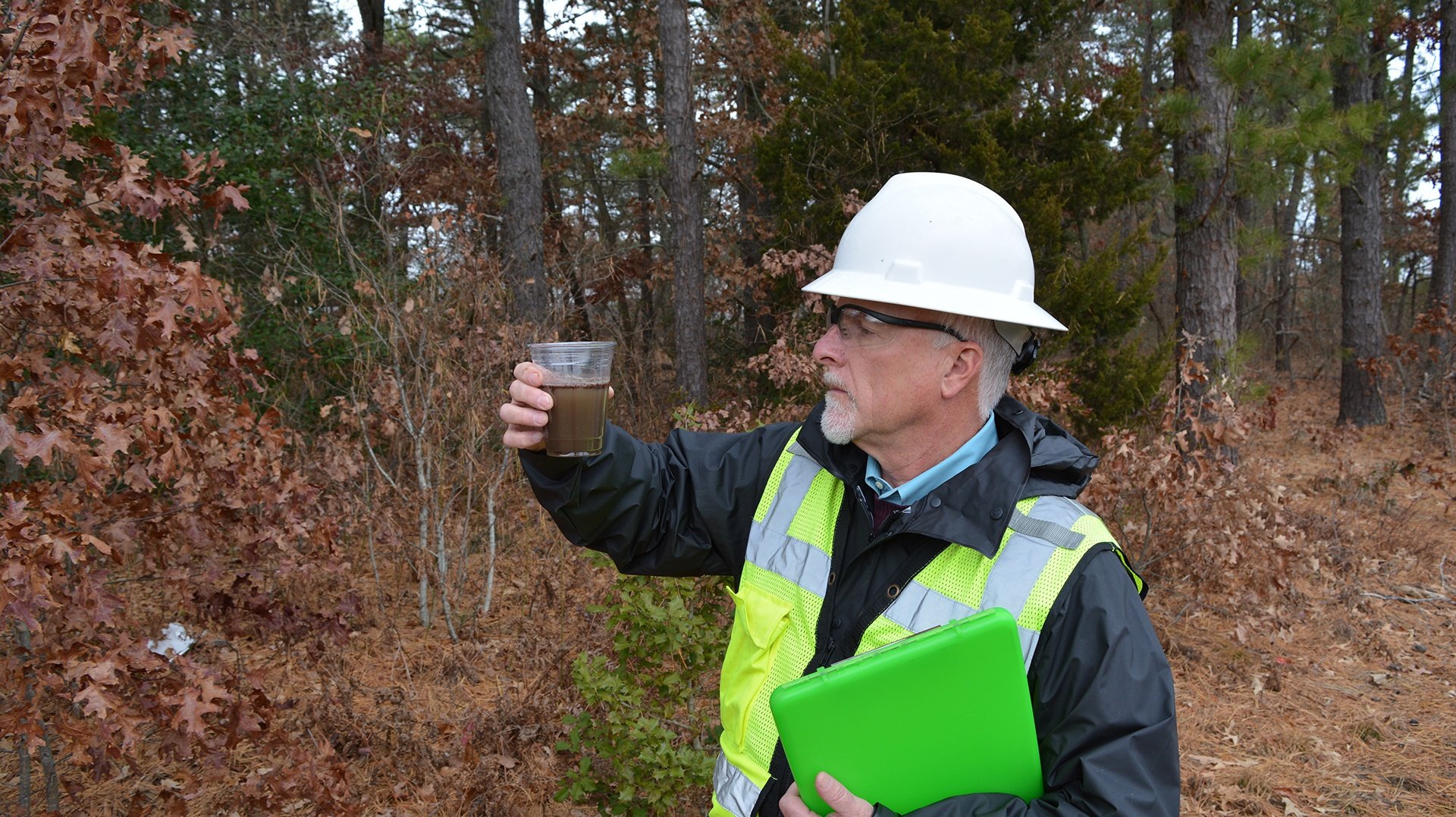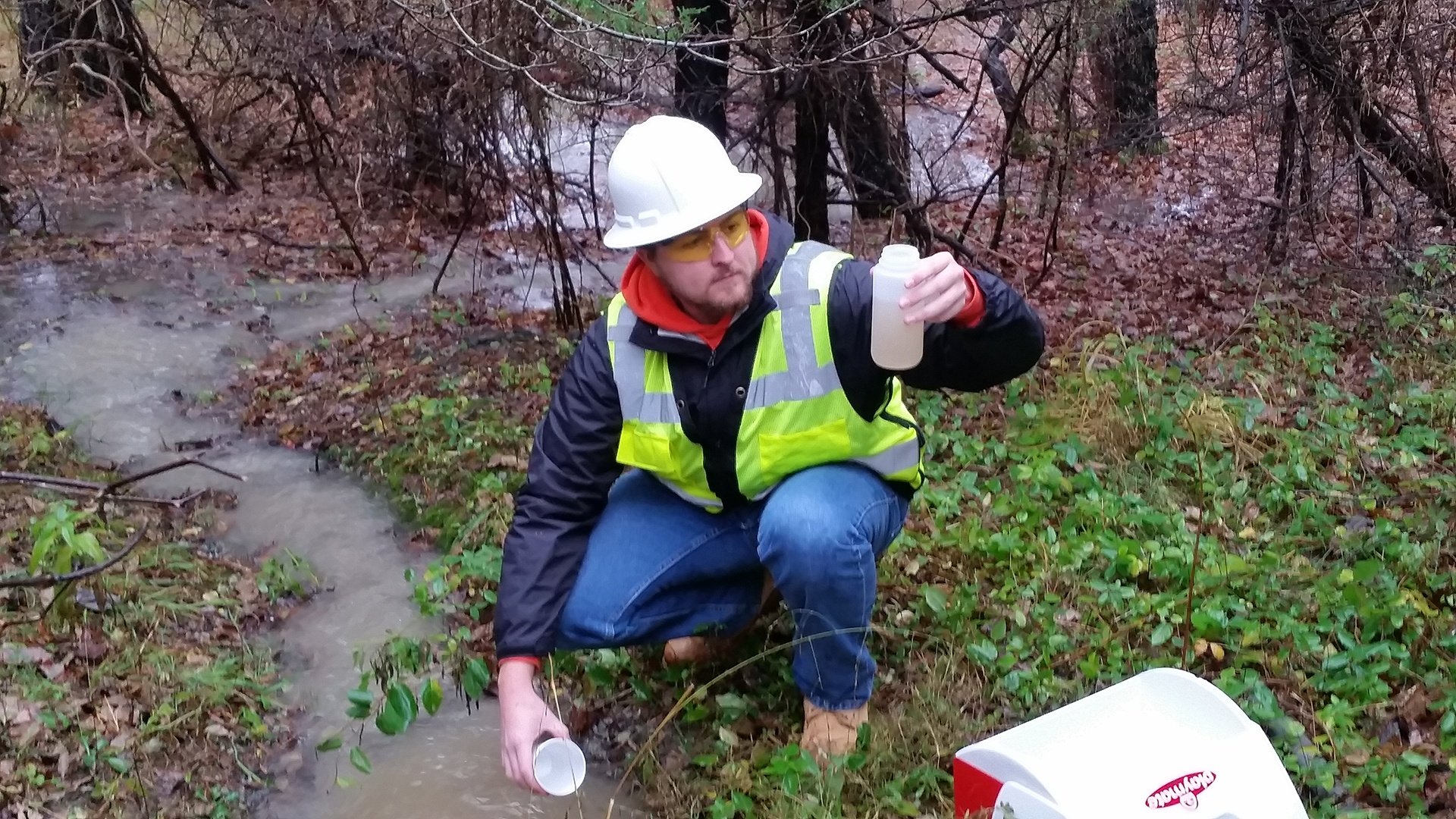Here's how to do a stormwater visual inspection.
Nearly every NPDES stormwater discharge permit in the United States, from the Federal Multi-Sector General Permit (MSGP) to state MSGPs and other state-specific stormwater discharge permits, a very common requirement in many of them is that permit holders (that means you) conduct "visual monitoring" of their stormwater discharges.
If you're not sure what that means, you can run into trouble, by visually inspecting the wrong thing, not using the correct form or improperly documenting what you're supposed to be looking for, or worse yet, not doing it!
Any, or all, of these can lead to big problems for you, including penalties and fines. So it's critical that you understand how to do a visual sample. In this article, we're going to dive right in and tell you how to do a visual stormwater sample, and hopefully make it easy enough that you actually gain some benefit from doing it.
The Right Way to Do a Stormwater Visual Inspection
So how do you go about conducting a visual stormwater monitoring inspection? We break it down into prep work and getting your stormwater sample.
The Prep Work for Stormwater Visual Inspections
- You need a stormwater discharge. - First of all, realize this simple, but fundamental aspect of doing your stormwater visual inspection. It has to be raining (or recently been raining), and your outfall needs to be discharging. No discharge, no sample. No sample, no inspection. It sounds elementary, but believe me, we've seen stormwater visual inspection results from facilities that reported no discharge during a quarter. What?? No discharge, yet you visually inspected a sample of, your discharge? It has to be raining, and more importantly, it has to be discharging.
- Know where to inspect. - The first time you have to do an inspection should not be the first time you've visited the outfall location. You need to know exactly where and how to get that stormwater sample, safely and correctly, before you even begin to consider going out there during a rain event. Go out there now, before it begins to rain, and figure out where the outfall location is, where you can grab a sample, where you'll be standing, and if there are any safety considerations you ought to consider beforehand. Be prepared.
- Know your paperwork. - Make sure you have the necessary forms (and a pen) to document your inspection results. Many states have their own stormwater visual inspection forms that you are required to use, not the back of a napkin, a scrap of paper, or whatever else you have on hand. A real, official form, that you'll use to document and record your evaluation. Get a copy in hand now, before you have to do the inspection. A word of advice, also get yourself a clipboard that you can write on, right after you do your stormwater visual inspection, it makes writing on that paper form a whole lot easier.
- Have gear ready to go. - Get yourself a clear container with which to scoop up a sample and to visually inspect it. We always recommend folks use a clear plastic Solo-style cup. They're not the best thing for getting a stormwater sample for monitoring or testing purposes, but they do just fine for a visual inspection. They're cheap, easy to get, bendable, hard to break, and you can get a whole sleeve of them and keep them in your office. You really don't need any fancy equipment for your stormwater visual inspection, and they work great.

Getting a Stormwater Sample for Your Visual Inspection
So presuming you've gone out at the right time, it's rained or is raining right now, and your stormwater outfall is discharging, what do you look for?
- Color - Is your stormwater any color that looks odd? Red, green, blue, black, brown, or purple? Maybe your discharge drains some area that imparts a natural background color, and maybe that's fine. If so, document that! For the rest of us, it should be clear.
- Clarity - Speaking of clear water, is your stormwater clear? Or, is it cloudy? If it's cloudy, how cloudy is it?
- Sheen - Is there a petroleum or oily sheen on the water? Obviously, that's not normal.
- Floating Materials - Is there something floating on top? Is it natural material, or is it trash, plastic, or something else?
- Suspended Materials - Is there anything hanging suspended in the water? Suspended sediment?
- Settled Materials - As soon as you picked up your sample, or shortly thereafter, did material settle to the bottom? What do you think it is? Sediment, leaves, what? And how much?
- Smell - Does the water smell? Typically stormwater won't an odor, but what if your sample had a chemical smell, or a petroleum smell, or just plain stunk? That's not normal, and should be recorded.
- Foam - Is there any foam on top, like might be present from soaps or similar? Are there any "suds" on the top?
- Anything Else - We always say, if you see anything out of the ordinary, or it's weird, etc., then you should record it.
We usually tell people, anything odd, different, unusual, things that don't look quite right. If your stormwater looks like crystal clear drinking water (great job!), then your inspection is going to be easy. But for most of us, there are things we're probably going to see. And when we do, we make note of what we see
What's the point of stormwater visual inspections?
Stormwater visual inspections can really be one of your best tools in maintaining NPDES stormwater permit compliance, as well as helping you make sure you're discharging stormwater that's as clean as possible.
Think of it, this simple, easy visual inspection can provide you instant feedback on how stormwater is being managed on your site. Look at it, and it's obviously dirty, smelly, discolored, oil sheen on it, etc., and you know you have a problem. Work on it, put good practices in place (stormwater BMPs), and get better visual results, and there you have immediate visual proof of your good efforts.
Very likely, if your stormwater sample looks cleaner, it's probably going to produce better lab analytical results, which are the hard numbers you report to the State or Feds. Dirty water, expect bad results. Cleaner water, expect better results. Simple.
We normally aren't required to discharge crystal clear stormwater from our sites under most NPDES stormwater discharge permits because that simply isn't realistic. But, using these visual stormwater inspections, we can easily and quickly gauge our progress not only towards permit compliance and better stormwater results but also towards cleaner water for all.

When do you need to take a visual sample of your stormwater?
You need to be darn sure of when you need to take a stormwater sample for a stormwater visual inspection, and how many times each year. Sure, you can do it every time it rains (maybe that might help), but you have an NPDES stormwater discharge permit that specifies how many times you must do it.
For example, the Federal MSGP and most State's MSGP permits specify that permit holders must do stormwater visual inspections on a quarterly basis, in other words, once every 3 months. What does your permit require?
Furthermore, most permits specify what type of storm event qualifies for a stormwater visual inspection. For example, many stormwater permits describe a "qualified storm event" that has certain requirements, such as it can't have rained within 72 hours before the storm event that's sampled, or that your visual sample has to be obtained within the first 30 minutes of discharge.
Again, you need to know this stuff before you begin. And, be advised, in some states you must take your stormwater visual inspection at the same time, or every time, you do a stormwater grab sample (collecting a sample for lab analysis).

Anything else?
In many cases, NPDES stormwater discharge permits require you to perform a pH analysis on your stormwater sample within 15 minutes of the sample collection. Whenever you perform a stormwater visual inspection, it can be a good time to get your pH analysis out of the way too! We recommend taking two separate samples (you're already in the rain and wet at this point, after all), and immediately performing a pH analysis on the first sample to make sure you're within that 15-minute window. Then, you can move along to the visual inspection of your second sample. Two samples, one storm - two birds, one stone. For a full breakdown of exactly what you’ll need to do to analyze the pH of your samples on-site, be sure to check out our online training course: The Best Way to Perform pH Analyses of Your Facility’s Discharge Samples.
Stormwater Visual Inspections ≠ Facility Inspections
One last thing, a visual stormwater inspection is NOT the same as doing a routine facility inspection.
A stormwater visual inspection is where you look at your stormwater discharge, while a facility inspection is where you are looking at conditions at your facility. Not the same at all. In fact, you may be required to conduct your facility inspections when it's not raining, or X number of times per year including one when it's raining, but the rest when it isn't, or some particular rules like that. Normally, you're going to be doing your facility inspections on dry days (who wants to walk around in the rain anyway?), and you'll have to do your stormwater visual inspection when it rains (yuck).
So while maybe you're conducting one of your facility inspections - during the one time per year when you're allowed to do the inspection in the rain - you might get lucky enough to double and also do a visual stormwater inspection. But again, your stormwater visual inspection and your facility inspection are not the same things, and one won't count for the other.

Does your facility need help with stormwater permit compliance?
For a lot of folks out there, regulations surrounding stormwater permits are a real pain to deal with. After all, you have a business to run! If you're overwhelmed, you're not alone. RMA has been actively involved in helping companies get and stay in compliance with stormwater permits across the United States since our founding in 1992. Long story short, we know the ins and outs of the environmental problems industrial and commercial facilities face and can help you get into compliance with stormwater permits and other applicable environmental laws and regulations, ensuring your business stays out of trouble and in compliance.
Our staff members have been on-site at thousands of operations across the country, so when we say we've seen it all and done it all, we mean it. We've helped everyone, from globe-spanning, multi-national organizations to small "mom & pop" operations. No matter your size or location, we'd love to learn how we can help.
So, if you're having any type of issue at your facility and need the help of an environmental consulting firm with a proven track record, reach out. Even if we can't help, we’ll do our best to steer you in the right direction. Feel free to contact us at info@rmagreen.com, click here to contact us, or give us a call anytime at 888-RMA-0230 to learn how we can help your facility deal with stormwater permits and other environmental regulations.

Additional Stormwater Permit Information















